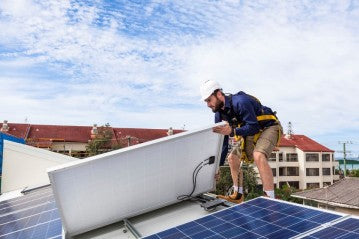
Solar power is rapidly gaining popularity as a clean and renewable energy source. With advancements in technology, solar panels have become more efficient and affordable, making them an attractive option for customers looking to harness the power of the sun. One common question that arises when considering solar energy is how many lights a solar panel can power. In this blog post, we will explore the factors that influence solar panel performance and shed light on the considerations when determining the number of lights a solar panel can effectively power.
1. Understanding Solar Panel Capacity
Solar panel capacity refers to the maximum amount of electricity a solar panel can produce under ideal conditions. It is typically measured in watts (W) and is an important factor to consider when estimating the number of lights a solar panel can power. The capacity of a solar panel is determined by its physical size, the number of solar cells it contains, and the efficiency of those cells in converting sunlight into electricity.
2. Factors That Influence Solar Panel Performance
Several factors can influence the performance of a solar panel and, consequently, the number of lights it can power. Some of the key factors include:
a. Sunlight Intensity: The intensity of sunlight directly affects the amount of electricity generated by a solar panel. Regions with higher levels of sunlight, such as deserts, tend to yield more energy than areas with frequent cloud cover.
b. Panel Orientation and Tilt: The angle and orientation of the solar panel play a crucial role in maximizing its exposure to sunlight. Panels that face south and are tilted at an optimal angle for the geographical location will generate more electricity.
c. Shading: Shadows cast on a solar panel can significantly reduce its performance. It is important to ensure that the panel remains unobstructed by nearby trees, buildings, or other objects that may cause shading.
d. Temperature: Solar panels operate more efficiently in cooler temperatures. Higher temperatures can reduce the overall output of a solar panel, affecting its ability to power lights effectively.
Also Read: Maximizing Solar Panel Performance: Avoiding the Shadow Effect for Optimal Energy Generation
3. Is It Possible For One Solar Panel To Power Various Types Of Lights?
The number of lights that a single solar panel can power depends on various factors, including the power consumption of the lights themselves. Solar panels produce direct current (DC) electricity, which needs to be converted into alternating current (AC) for most types of lighting. The power consumption of lights can vary greatly, from energy-efficient LED lights to high-power halogen or incandescent bulbs.
To determine the number of lights a solar panel can power, it is important to consider the total power consumption of the lights and match it with the solar panel's capacity. It is also crucial to factor in the efficiency of the inverter, which converts DC electricity into AC.
4. How Do Sunlight Hours Affect the Number Of Lights A Solar Panel Can Power?
The number of sunlight hours in a day is an essential factor to consider when estimating the number of lights a solar panel can power. Sunlight hours vary based on geographical location and time of year. In regions with shorter daylight hours, the overall energy generated by a solar panel will be lower, affecting the number of lights it can sustain.
To optimize solar panel performance, it is important to consider seasonal variations and the impact of weather conditions. Additionally, incorporating a battery storage system can help store excess energy generated during peak sunlight hours, ensuring a consistent power supply for lights during periods of low sunlight or at night.
5. How Does the Efficiency Of A Solar Panel Impact The Number Of Lights It Can Power?
Solar panel efficiency refers to the percentage of sunlight that a panel can convert into usable electricity. Higher efficiency panels can generate more electricity for a given surface area, allowing them to power more lights.
Efficiency is influenced by various factors, including the quality of solar cells, the manufacturing process, and the materials used. It is important to select solar panels with higher efficiency ratings to maximize the energy output and increase the number of lights that can be powered.
Conclusion
Solar power offers a sustainable and environmentally friendly solution for powering lights and other electrical devices. When determining the number of lights a solar panel can power, it is essential to consider factors such as solar panel capacity, sunlight intensity, panel orientation, shading, temperature, power consumption of lights, sunlight hours, and solar panel efficiency.
By understanding these factors and consulting with solar energy professionals, customers can make informed decisions when purchasing solar panels and effectively power their desired number of lights. Solar power presents a bright future, illuminating our homes and businesses with clean and renewable energy.
Remember, each solar panel has its unique specifications, and it is advisable to consult with solar energy experts to accurately determine the number of lights a solar panel can power based on your specific requirements. Harness the power of the sun and embrace a greener, brighter future with solar energy.
Ecgsolax has more than a decade of experience in the solar industry, and we’re dedicated to providing you with everything you need for your solar system, including deep cycle batteries, all in one inverters, solar charge controllers, etc.


0 Kommentare